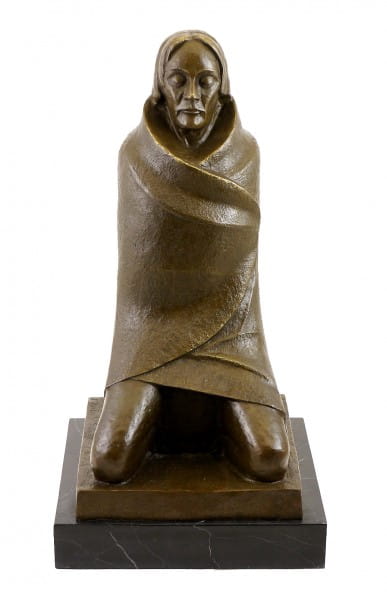Prices incl. VAT, free shipping worldwide
Ready to ship today,
Delivery time appr. 3-6 workdays










Product description
"Bronze figure - The Ascetic / Praying Man (1925) Ernst Barlach"
| Height | 48 cm |
| Width | 23 cm |
| Length | 26 cm |
| Weight | 13,7 kg |
"The Ascetic / Praying Man" – Bronze Sculpture by Ernst Barlach (1925)
This exceptional bronze sculpture, titled "The Ascetic / Praying Man," is a timeless creation by the renowned German expressionist sculptor and writer Ernst Barlach. Created in 1925, this piece encapsulates Barlach’s deeply humanistic approach to art, emphasizing spirituality, introspection, and the endurance of the human spirit. With its minimalist yet deeply emotive design, the sculpture stands as a testament to Barlach’s ability to distill complex emotions into powerful, simple forms.
The Artist: Ernst Barlach – A Voice of Expressionist Sculpture
Ernst Barlach was born on January 2, 1870, in Wedel, Schleswig-Holstein, Germany. Recognized as one of the leading figures of German Expressionism, Barlach worked across multiple disciplines, including sculpture, drawing, and literature. His work is defined by its focus on existential themes, spiritual depth, and empathy for human struggle, making him one of the most profound artistic voices of his time.
Barlach studied at the Hamburg School of Applied Arts and later at the Royal Academy of Fine Arts in Dresden. His travels to Russia in 1906 greatly influenced his artistic vision, introducing him to folk art traditions that emphasized simplicity and emotional resonance. He began creating sculptures that broke away from classical norms, opting instead for stark, expressive forms that spoke to the universal human experience.
Barlach’s career was tragically interrupted during the Nazi era, as his works were labeled "degenerate art," and many were removed from public display. Despite this, his legacy endures, and his pieces are celebrated worldwide for their timeless emotional depth.
The Creation of "The Ascetic / Praying Man" (1925)
"The Ascetic / Praying Man" was created during one of the most productive periods of Barlach’s career, a time when his focus on spirituality and human endurance took center stage. This piece reflects his deep exploration of faith, humility, and the inner struggle of the individual.
The sculpture portrays a seated, cloaked figure with hands clasped in prayer and a bowed head, capturing a moment of profound introspection and devotion. The simple yet powerful lines of the figure convey a universal sense of spiritual longing and human vulnerability, transcending cultural and temporal boundaries.
Barlach often drew inspiration from his literary works and personal spiritual reflections, and "The Ascetic / Praying Man" is no exception. Created in Germany, it reflects the post-World War I atmosphere of societal rebuilding and personal resilience, resonating with a generation seeking solace and meaning.
Design and Symbolism
The figure’s posture—kneeling with the head bowed and hands clasped—symbolizes humility, surrender, and the search for inner peace. The enveloping cloak, a recurring motif in Barlach’s work, serves as both a protective barrier and a metaphor for isolation and contemplation.
This sculpture’s minimalist design enhances its emotional impact. The absence of extraneous detail focuses the viewer’s attention on the figure’s essence, encouraging a personal, almost meditative connection with the work. The figure’s quiet strength reflects Barlach’s belief in the resilience of the human spirit and the power of faith.
Materials and Craftsmanship
This sculpture is cast in bronze, a material Barlach favored for its ability to capture both strength and subtlety. The lost-wax casting technique ensures precision in every detail, from the soft folds of the cloak to the delicate contours of the figure’s hands and face. The warm, earthy patina adds depth to the sculpture, emphasizing its timeless and grounded quality.
The piece is mounted on a polished base, providing stability and enhancing its aesthetic presence. The combination of robust materiality and spiritual symbolism makes "The Ascetic / Praying Man" a deeply impactful work of art.
Cultural and Historical Context
Created in the aftermath of World War I, "The Ascetic / Praying Man" reflects the collective yearning for spiritual renewal and personal resilience during a period of profound societal upheaval. Barlach’s work often engaged with themes of suffering, faith, and the human condition, making his sculptures particularly poignant in times of crisis.
This piece exemplifies Barlach’s philosophy that art should speak directly to the soul, transcending superficial beauty to reveal deeper truths. It is both a personal meditation and a universal statement, resonating with viewers across cultures and generations.
Perfect for Collectors and Institutions
"The Ascetic / Praying Man" is a rare and extraordinary piece, ideal for collectors of Expressionist art and institutions dedicated to preserving cultural history. Its combination of emotional resonance, spiritual depth, and artistic mastery ensures that it remains a focal point wherever it is displayed. Whether in a private collection, museum, or contemplative space, this sculpture invites reflection and dialogue.
"The Ascetic / Praying Man" by Ernst Barlach is a masterful exploration of spirituality, resilience, and the universality of human experience. Created in 1925, it captures a moment of profound introspection and humility, making it a timeless and emotionally evocative work. With its impeccable craftsmanship, minimalist design, and deep symbolism, this bronze sculpture is a lasting testament to Barlach’s genius and a treasure for art lovers worldwide.
Our advantages
free shipping
Worldwide free shipping
14 days money back
You can cancel your order
within 14 days
secure payment services
Paypal, Master Card, Visa, American Express and more



























































